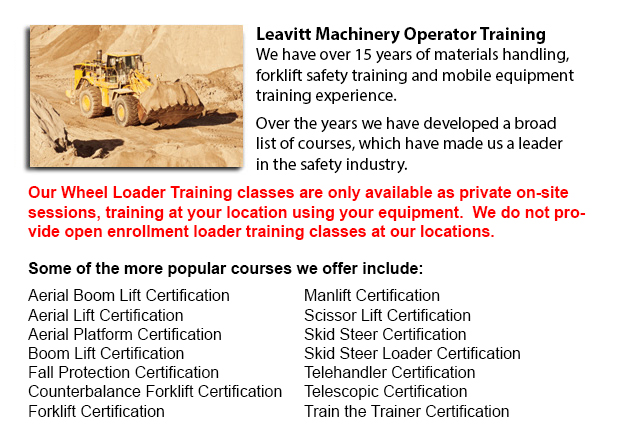
St Catharines Wheel Loader Operator Training - Cranes are industrial machines that utilize levers or pulleys to be able to lift substantial loads. The Roman people used cranes in order to build huge monuments, which means these equipment have been around for at least 2,000 years. Several Medieval churches used cranes in their creation and the Egyptians might have used them when constructing the pyramids.
The new type of a crane can be either complex or simple, and cranes vary based on their use. Mobile cranes, for example are quite simple. A steel truss or telescopic boom mounts its movable platform. A system of pulleys or levers lifts the boom and there is normally a hook suspended. These cranes are often used for demolition or earthmoving by changing the hook out with one more piece of device like for example a bucket or wrecking ball. Telescopic cranes have a series of hydraulic tubes which fit together to form the boom. These units can even be mobile.
Traditional wheels, or particular wheels used for a caterpillar track or railroad track allow these mobile booms to be able to navigate unpaved and uneven surfaces.
Rough terrain and truck mounted cranes are mobile as well. Outriggers are positioned on the truck mounted unit to be able to improve stability, while rough terrain cranes include a base which tends to resemble the bottom of a 4-wheel drive. These cranes are equipped to work on rough ground making them best in the construction trade for instance.
Gantry cranes are actually used so as to move and unload big containers off of ships and trains. They are normally found functioning in railroads and ports. Their bases consist of massive crossbeams that run on rails so as to pick up containers from a location to another. A portainer is a special kind of gantry which transports materials onto and off of ships specifically.
Essential to the shipping trade, floating cranes could be attached on pontoons or barges. Being placed in water, they are excellent for use in building bridges, port construction and salvaging ships. Floating cranes could handle very heavy loads and containers and like portainers, they could also unload ships.
Loader cranes are fit onto trailers together with hydraulic powered booms in order to load supplies onto a trailer. Whenever not being utilized, the jointed parts of the boom can be folded down. This particular type of crane could be also considered telescopic since one section of the boom can telescope for more versatility.
Often found in automated warehouses, stacker cranes tend to follow an automatic retrieval system and could work using a remote. These cranes are outfitted with a lift truck machinery and can be seen in large automated freezers, stacking or obtaining food. Utilizing this particular kind of system enables staff to remain out of that freezing setting.
Tower cranes are frequently the tallest cranes and typically do not have a movable base. They must be put together part by part. Their base is similar to a long ladder with the boom at right angles to the base. These cranes specialize in the construction of tall buildings and are usually affixed to the inside of the building itself through the construction period.
-
St Catharines Heavy Equipment Training Schools
St Catharines Heavy Equipment Training Schools - When selecting an operator training course, there are a lot of heavy equipment training schools to choose from. To be able to ascertain the qualifications you will attain, it is very important to explo... More -
St Catharines Heavy Equipment Operator Training
St Catharines Heavy Equipment Operator Training - Heavy equipment operator training facilities that offer quality standards within the business, offering field performance work and additional machine training are really sought after training features... More -
St Catharines Forklift Training Programs
St Catharines Forklift Training Programs - Are you looking for work as a driver of a forklift? Our regulatory-compliant mobile equipment operator training offers instruction in kinds of forklifts, pre-shift check, fuel kinds and handling of fuels, an... More -
St Catharines Heavy Equipment License
St Catharines Heavy Equipment License - A heavy equipment license can be obtained by taking a certification and preparation course at a private training school or a vocational school. This license would qualify you to operate various types of heavy e... More -
St Catharines Overhead Crane Safety Training
St Catharines Overhead Crane Safety Training - Overhead crane safety training equips operators with skills and knowledge regarding crane safety precautions, accident avoidance, materials handling, and equipment and stock protection. Trainees will lea... More -
St Catharines Scissor Lift Training
St Catharines Scissor Lift Training - Scissor lifts should be operated proficiently to be able to protect the safety of the equipment and the wellbeing of others within the workplace. Operators who are skilled are trained to drive the specific type o... More -
St Catharines Telescopic Training
St Catharines Telescopic Training - Telescopic Handlers are a kind of forklift, normally known as telehandlers. This machine has been increasing in popularity due to its greater lift heights and its versatility. It is often preferred over the convent... More -
St Catharines Boom Lift Certification
St Catharines Boom Lift Certification - Utilizing elevated work platforms allow for maintenance operations and work to be carried out at elevated work heights which were otherwise unreachable. Boom Lift Certification Training educates workers about t... More

Forklift Certification St Catharines
TOLL FREE: 1-888-254-6157
St Catharines, Ontario
forkliftcertificationstcatharines.com/
Email Us
About Us


